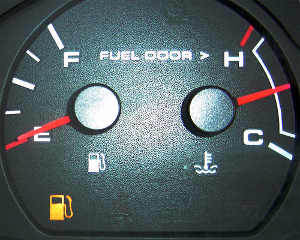Guide To Vehicle Fuel Lights

Have you ever wondered how far you can actually drive once the fuel warning light comes on in your vehicle? It’s a question many car and van drivers have asked themselves, not just people working in the motor trade, and unfortunately, there’s no easy answer.
In this article, we’ll take a closer look at what you should do when the fuel light comes on, and how to avoid getting stranded.
First things first, when the fuel light comes on, it’s a sure sign that the vehicle is running low on fuel, and as a rule you should refuel as soon as possible.
The ‘fuel low’ indicator is usually triggered when your tank’s capacity is under 15%, so there’s no need to panic just yet. However, when the light starts flashing, it means that the situation has become a bit more urgent, and you should aim to refuel as soon as possible.
While some cars may have a digital display that gives an estimate of how many miles you have left, these aren’t always accurate.
It’s a common belief that a car can go for up to 50 additional miles after the light goes on, but this can be tricky to track.
The truth is, how far you can drive once the fuel warning light comes on varies from old vehicle to new vehicle.
There’s no statutory amount that should be left in the tank before the dashboard fuel light comes on, so you shouldn’t assume that you’ve got a set number of miles left when it first alerts you.
Running out of fuel isn’t illegal, but it’s stressful and potentially dangerous. If you find yourself in this situation, it’s essential to find a safe place to pull over and put your hazard lights on.
You can then call a friend or family member to bring a jerry can or contact your breakdown company if you have road recovery insurance.
Driving with low fuel levels not only puts you at risk of breakdown, but it could also damage your car. As the fuel level gets lower, the car starts picking up debris from the bottom of the tank, which could damage the fuel filter and pump, as well as the catalytic converter.
If you run out of petrol, it can cause the fuel pump to run dry, resulting in a visit to your local garage mechanic and an unexpected bill.
With diesel cars, the engine management system should shut down before you run out of fuel, preventing damage to the car. However, with petrol cars, there’s no system in place to prevent this.

Getting stranded is another concern that should be taken seriously. You might be on the motorway with cars whizzing past you at high speed. But wherever you break down could be dangerous, especially if you’ve broken down after a bend in the road.
If you end up stranded in the middle of the road or your breakdown leads to an accident, you could be prosecuted for careless or dangerous driving which could lead to a possible fine and penalty points being added to your driving licence, which in turn could raise your private or motor trade insurance costs.
Newer diesel vehicles can be more fuel efficient than petrol, but the mileage to empty should be roughly the same.
It all really depends on the make and model. Remember not to always use the fuel warning light as a reminder to fill up with fuel as soon as possible.







